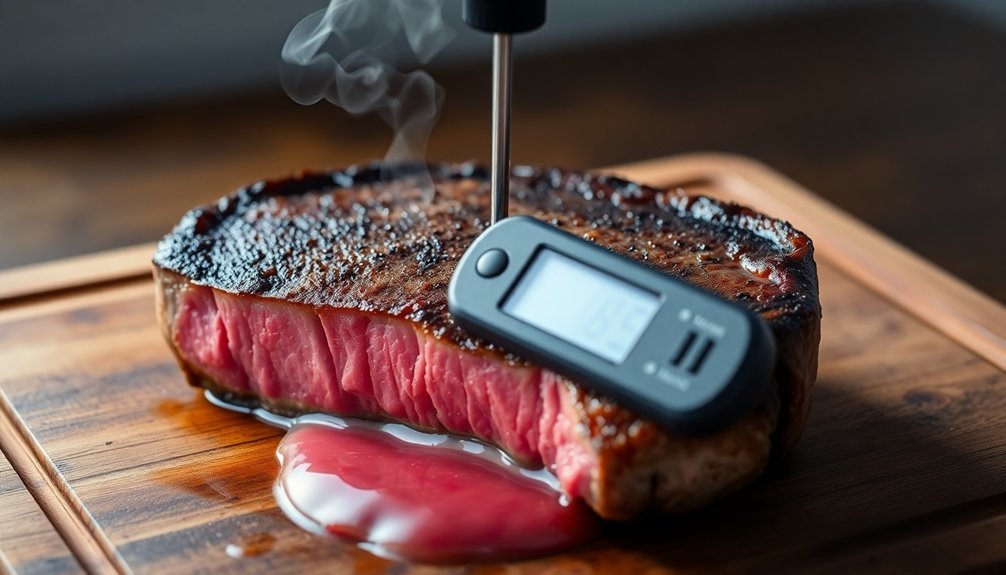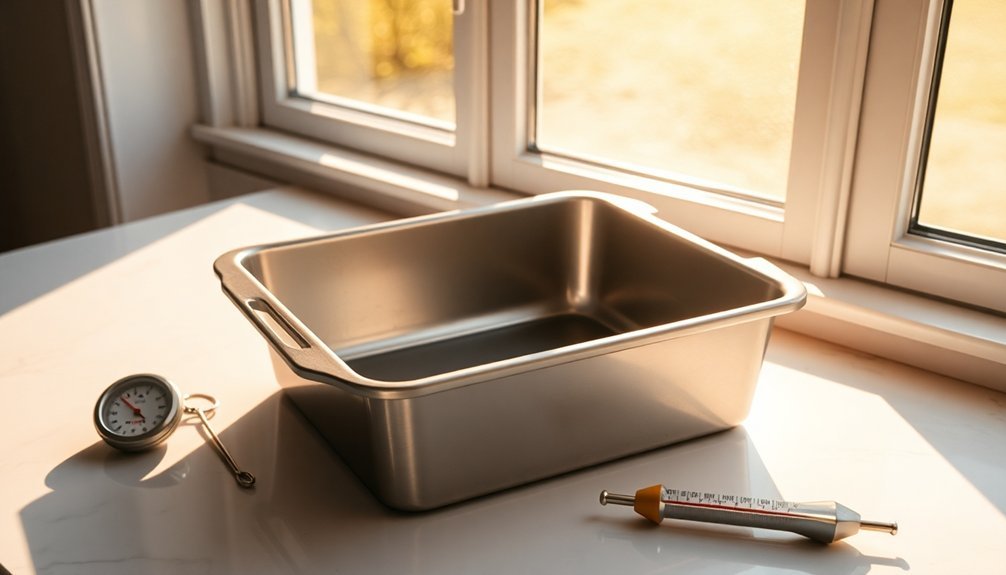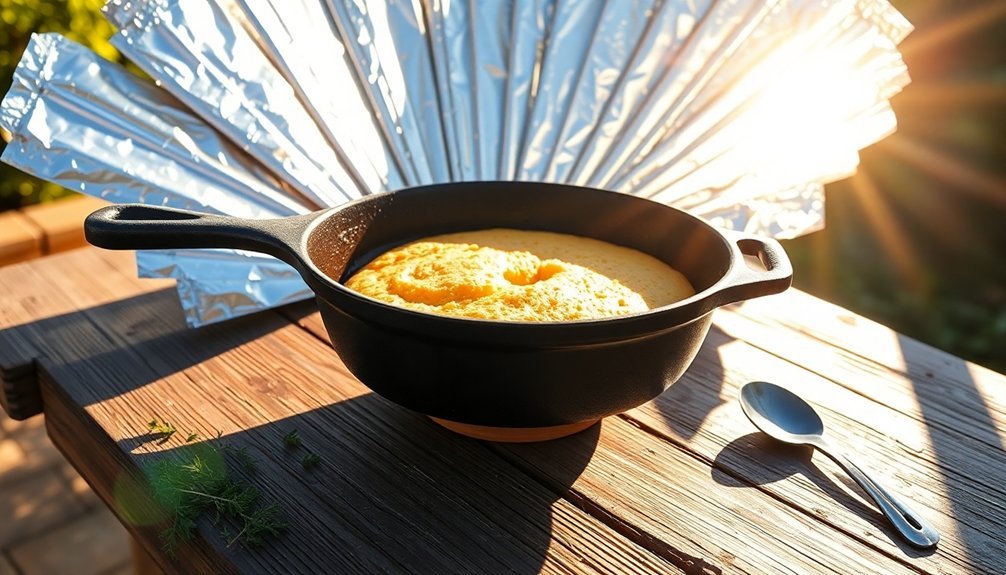You need to cook meat to specific safe temperatures because dangerous bacteria like E. coli and Salmonella can make you seriously ill. These harmful pathogens thrive in the "danger zone" between 40°F and 140°F, where they can double in number every 20 minutes. When you heat meat properly (165°F for poultry, 160°F for ground meats, and 145°F for fish), you're destroying these bacteria through protein denaturation, which breaks down the enzymes they need to survive. While different cuts require different temperatures, understanding the science of safe cooking temperatures can protect you and your loved ones from foodborne illness.
The Science Behind Safe Temperatures

While cooking meat might seem like a simple task, understanding the science behind safe temperatures is essential for preventing foodborne illness. When you heat meat to specific temperatures, you're triggering several vital biological processes that make it safe to eat.
At the molecular level, heat causes protein denaturation in harmful bacteria like E. coli and Salmonella, effectively killing these pathogens by disrupting their cellular structures. Proper temperatures also inactivate the enzymes these bacteria need to survive and multiply.
You'll need to reach different temperature thresholds depending on the type of meat – for instance, 160°F for ground meats and 165°F for poultry. Using a reliable thermometer isn't just about following guidelines; it's about ensuring these biological processes occur completely throughout the meat, eliminating dangerous microorganisms. When checking meat temperature, remember that the sensor at the tip provides the most accurate reading for determining doneness.
Dangers of Undercooked Meat
You're risking serious foodborne illness when consuming undercooked meat, as bacteria like Salmonella and E. coli thrive in temperatures between 40°F and 140°F (4°C-60°C).
Raw or undercooked meats provide the perfect environment for dangerous pathogens to multiply rapidly, potentially leading to severe food poisoning symptoms including nausea, vomiting, and diarrhea. Symptoms can appear anywhere from 30 minutes to 1 week after eating contaminated meat.
These risks are especially concerning for vulnerable populations like pregnant women, young children, and the elderly, who may experience more severe complications from foodborne infections.
Bacteria Growth Danger Zones
Understanding the "danger zone" for bacterial growth is essential when cooking meat. When temperatures fall between 8°C and 60°C (40-140°F), bacteria multiply rapidly, doubling every 20 minutes.
You'll find this growth is fastest between 21°C and 47°C (70-117°F).
If you leave meat in this danger zone for over two hours, you're risking serious foodborne illness. Common bacteria like Salmonella, E. coli, Campylobacter, and Listeria thrive in these conditions, potentially causing severe symptoms from stomach cramps to kidney failure.
You're especially at risk when consuming undercooked ground beef, raw eggs, or improperly stored meats. Food must be cooked to 70°C in England to ensure all harmful bacteria are destroyed.
To stay safe, you'll need to cook meat thoroughly to an internal temperature of at least 75°C. Always use a meat thermometer to check, and avoid keeping food in the danger zone.
Uncooked Pathogen Growth
Raw meat naturally harbors various dangerous pathogens that can cause severe illness if not properly cooked. You'll find bacteria like Salmonella, E. coli, and Staphylococcus aureus throughout the meat, particularly in ground products where pathogens can be distributed inside, not just on the surface.
| Pathogen | Health Risk |
|---|---|
| E. coli O157:H7 | Severe illness, potential death |
| Salmonella | Gastrointestinal illness, fever |
| Trichinella | Parasitic infection, muscle pain |
If you don't cook meat thoroughly, these pathogens can survive and multiply. Ground meats are especially risky since bacteria mix throughout during processing. You're at greater risk if you're elderly, young, or immunocompromised. The high water activity and nutrient content in raw meat create perfect conditions for bacterial growth, making proper cooking essential for your safety.
Common Food Poisoning Risks
When consuming undercooked meat, you're exposing yourself to several dangerous foodborne pathogens that can cause severe illness.
E. coli, found primarily in ground beef, can trigger bloody diarrhea and potentially life-threatening kidney damage. You'll find Salmonella most commonly in undercooked poultry, causing severe dehydration and gastrointestinal distress that affects millions annually.
Campylobacter in undercooked poultry can lead to serious complications like Guillain-Barré syndrome, while Listeria poses a particular threat to pregnant women, potentially causing miscarriage or stillbirth.
If you're in a high-risk group – including young children, elderly, pregnant women, or those with weakened immune systems – you're especially vulnerable to severe complications from these pathogens.
Even healthy adults can experience lasting health issues from food poisoning.
Ground Meat Safety Guidelines

Proper handling and cooking of ground meat requires strict attention to temperature guidelines, as bacteria can spread throughout the entire product during grinding.
You'll need to cook all ground meats to 160°F (71°C) to eliminate harmful pathogens like E. coli and Salmonella. Using a food thermometer isn't optional – it's vital for ensuring your meat reaches the proper temperature throughout.
- Always insert the thermometer into the thickest part of the meat
- Keep raw ground meat separate from other foods to prevent cross-contamination
- Wash your hands thoroughly before and after handling raw meat
- Store ground meat in the refrigerator until you're ready to cook
- Reheat leftovers to 165°F (74°C) for safety
These steps are particularly important for protecting vulnerable groups like children and the elderly from foodborne illness.
Poultry Temperature Requirements
Like ground meat, poultry demands specific temperature requirements – but with even stricter standards. You'll need to cook all poultry, whether it's whole birds, pieces, or ground meat, to 165°F. This temperature isn't arbitrary – it's the point where harmful bacteria like Salmonella are immediately killed.
You must verify these temperatures using a reliable meat thermometer. When cooking a whole bird, check the innermost part of the thigh and wing. For pieces, insert the thermometer into the thickest portion.
While cooking times vary by method – such as 6-8 minutes per side for grilled breasts or 20-30 minutes for roasted pieces – temperature is your ultimate safety guide. Don't rely on color or texture alone; your thermometer is your best tool for ensuring safe poultry consumption.
Fish and Shellfish Standards

Fish and shellfish require distinct temperature standards based on their delicate protein structures. You'll need to pay close attention to specific temperatures, as these proteins are highly sensitive to heat.
While the USDA recommends 145°F for fish, you can safely cook salmon to 125°F for medium or even 110°F for rare. Shellfish have their own unique requirements, with shrimp needing 135-140°F and mussels requiring a higher 165°F.
- Salmon cooks perfectly at 125°F for medium, preserving its moisture
- Use a thermometer to prevent overcooking delicate fish proteins
- Cook shellfish until they open, discarding any that remain closed
- Different shellfish need varying temperatures (scallops 130°F, lobster 140°F)
- Pan-searing, grilling, and baking are effective cooking methods for seafood
Solar Cooking Temperature Control
Controlling temperature in solar cooking requires careful attention to four key elements: positioning, insulation, light management, and monitoring. You'll need to position your oven directly facing the sun and adjust it every 30-45 minutes for ideal heat collection. Proper insulation using materials like newspaper or fiberglass will help maintain consistent temperatures.
| Time | Action | Temperature Goal |
|---|---|---|
| Setup | Face oven toward sun | N/A |
| Start | Monitor thermometer | 150°F |
| 30 min | Adjust position | 175°F |
| 60 min | Check food safety | 200°F |
| 90 min | Final temperature | 225°F |
To maximize efficiency, use dark cookware and reflective panels to concentrate sunlight. Keep track of temperatures with a reliable thermometer, ensuring food stays above 125°F or below 50°F to prevent spoilage. If temperatures drop, quickly reheat food to boiling point for safety.
Using Meat Thermometers Effectively

Properly using a meat thermometer can mean the difference between a perfectly cooked meal and a food safety hazard.
You'll need to insert the thermometer into the thickest part of your meat, avoiding bones, fat, or gristle. For thin cuts, insert it sideways to reach the center accurately.
Choose your thermometer based on your cooking method. Dial oven-safe models work well for roasts, while instant-read types are perfect for quick temperature checks.
- Always place the thermometer in the innermost part of thigh and breast for whole poultry
- Test accuracy using ice water or boiling water before each use
- Monitor ground meats until they reach 160°F
- Cook whole poultry to 165°F for food safety
- Let steaks and roasts rest for three minutes after reaching 145°F
Temperature Danger Zones
Understanding temperature danger zones is essential for food safety. When food sits between 41°F and 135°F, bacteria multiply rapidly, especially in the critical range of 70°F to 125°F where they can double every 20 minutes.
Even if food looks and smells fine, it could harbor dangerous bacteria like Salmonella and E. coli.
You'll need to keep hot foods above 135°F and cold foods below 41°F to prevent bacterial growth. Don't leave ready-to-eat foods in the danger zone for more than 4 hours.
If you're holding cold foods without refrigeration, they're safe for up to 6 hours if they started at 40°F or below.
Remember to check food temperatures every 2 hours and quickly reheat leftovers to 165°F to guarantee safety.
Proper Food Storage Methods

You'll need to monitor your refrigerator's temperature daily using a reliable thermometer placed on the bottom shelf where it's typically warmest.
Keep raw meats properly stored according to their safe time limits: ground meats for 1-2 days, fresh poultry for 1-2 days, and fresh cuts of beef, veal, or pork for 3-5 days.
You can track these storage durations and temperatures using a simple log to guarantee food stays within safe consumption windows.
Temperature Monitoring Techniques
Modern technology has revolutionized temperature monitoring in food storage, offering a range of solutions from simple thermometers to sophisticated IoT systems.
You'll find smart sensors that connect to central networks, providing real-time alerts and automated temperature control. Bluetooth-enabled devices let you check temperatures instantly on your smartphone, while RFID solutions offer passive monitoring throughout the food's journey.
- Digital thermometers give you precise core temperature readings
- Infrared thermometers measure surface temperatures without contact
- IoT sensors automatically track and adjust temperatures in storage areas
- Bluetooth devices enable immediate access to temperature data via mobile devices
- RFID tags monitor temperatures during transport and storage without manual checks
These monitoring techniques guarantee your meat reaches and maintains safe temperatures from storage through cooking, helping you prevent foodborne illness and maintain quality.
Refrigeration Time Limits
Proper storage times and temperatures work hand-in-hand with monitoring techniques to keep your food safe.
You'll need to refrigerate or freeze meat, poultry, eggs, and other perishables immediately after purchase. Don't let raw meat, cut produce, or cooked foods sit at room temperature beyond two hours – or one hour if it's above 90°F.
Keep your refrigerator at 40°F or below and store raw meats on lower shelves, beneath cooked foods.
You'll want to use shallow containers for leftovers to facilitate faster cooling. Follow the "first in, first out" method and check use-by dates regularly.
For peak safety, keep hot foods above 140°F and cold foods below 40°F to avoid the danger zone where bacteria thrive.
Store foods in covered containers and avoid overstuffing your refrigerator to maintain proper air circulation.
Heat Distribution in Solar Cooking
Unlike traditional cooking methods that rely on direct heat sources, solar cooking harnesses and distributes heat through a combination of reflection, absorption, and retention.
You'll find that the heat distribution in solar cooking is remarkably even, reaching temperatures between 180°F to 250°F. The process starts with reflective panels concentrating sunlight onto your dark-colored cooking vessel, where it's absorbed and converted to heat energy. A transparent cover traps this heat, creating a stable cooking environment.
- Reflective surfaces concentrate UV rays onto the cooking area
- Dark-colored pots absorb solar energy efficiently
- Clear covers create a greenhouse effect to trap heat
- Heat distributes evenly throughout the vessel without stirring
- Food cooks gently, preserving nutrients and moisture
Bacteria Growth Prevention Techniques

You'll need to know that bacteria thrive between 40°F and 140°F, making this range particularly dangerous for food storage and handling.
Your refrigerator should maintain temperatures below 40°F, while hot foods must stay above 140°F to prevent bacterial growth.
To guarantee food safety, you should monitor temperatures regularly and never leave perishable items in the danger zone for more than two hours.
Temperature Danger Zone Basics
Understanding the temperature danger zone is essential for food safety, as bacteria thrive and multiply rapidly between 40°F and 140°F (4°C and 60°C). In this range, bacteria can double every 20 minutes, making your food unsafe to eat.
You'll need to keep hot foods above 140°F and cold foods below 40°F to prevent dangerous bacterial growth.
- Bacteria multiply fastest in protein-rich, moist foods
- Time and temperature work together – the longer food stays in the danger zone, the riskier it becomes
- Multiple factors affect bacterial growth, including moisture, salt, and acidity
- You must cool foods from 140°F to 70°F within 2 hours
- When reheating, guarantee food reaches 165°F for at least 15 seconds
To protect yourself and others, always use a food thermometer to verify temperatures and minimize time spent in the danger zone.
Monitoring Cold Chain Storage
Maintaining an effective cold chain storage system is critical for preventing bacterial growth and guaranteeing food safety. You'll need to monitor temperatures consistently, keeping refrigerated storage between 2-8°C and freezer storage at -18°C or below. Regular checks of temperature monitoring systems help guarantee your food stays within safe ranges.
| Storage Type | Temperature Range | Purpose |
|---|---|---|
| Refrigeration | 2-8°C (36-46°F) | Slow bacterial growth |
| Freezing | -18°C (0°F) or below | Prevent spoilage |
| Blast Freezing | -35°C (-31°F) | Rapid parasite reduction |
To prevent cross-contamination, you'll need to store different food products separately in sealed containers. Remember to cool cooked foods quickly – from 60°C to 20°C within two hours, then to 4°C within four hours. Keep your storage units clean and promptly wipe up any spills to maintain a safe environment.
Common Cooking Temperature Mistakes
Despite seeming straightforward, cooking meat to the right temperature trips up even experienced home chefs.
You'll need to avoid common mistakes like cooking meat straight from the fridge, which causes uneven heating, or skipping the essential rest period that keeps juices locked in.
Using your thermometer correctly is vital – always insert it into the thickest part, away from bones and fat.
- Not checking internal temperature with a reliable thermometer
- Failing to let meat reach room temperature before cooking
- Overcrowding the pan, preventing proper browning
- Not maintaining required temperature for the specified time
- Cutting meat too early after cooking, losing valuable juices
Remember that different meats require different temperatures – 145°F for fresh cuts, 160°F for ground meats, and 165°F when reheating leftovers.
Frequently Asked Questions
Can I Safely Eat Medium-Rare Hamburgers if the Meat Is Fresh?
You shouldn't eat medium-rare burgers with store-bought ground beef. If you're using fresh, home-ground meat, you'll need to cook it sous-vide at 131°F for 4+ hours to guarantee safety.
Does Marinating Meat Affect the Required Internal Cooking Temperature?
No, marinating doesn't change the required internal cooking temperatures for your meat. You'll still need to reach the same safe temperatures regardless of how long you've marinated or what ingredients you've used.
How Long Can Cooked Meat Stay Warm Before Needing Refrigeration?
You shouldn't keep cooked meat in the temperature danger zone (41°F-135°F) for more than 4 hours total. If you're serving it hot, maintain it at 135°F or above, otherwise refrigerate it promptly.
Should Wild Game Meat Be Cooked to Different Temperatures Than Store-Bought Meat?
Yes, you'll need to cook wild game at higher temperatures than store-bought meat. Wild game requires 160-170°F due to potential parasites, while store-bought meat is generally safe at lower temperatures like 145°F.
Can Altitude Affect Recommended Meat Cooking Temperatures?
Yes, altitude can affect your cooking process. You'll need longer cooking times at high elevations since water boils at lower temperatures. While safe internal temperatures don't change, you'll need to adjust cooking methods accordingly.
In Summary
You'll find that reaching proper cooking temperatures isn't just about taste – it's vital for your safety. By following recommended temperature guidelines, you're killing harmful bacteria and parasites that could make you sick. Don't rely on color or texture alone; always use a meat thermometer to guarantee your food has reached safe internal temperatures. Remember, proper cooking temps protect you and your family from foodborne illness.





Leave a Reply